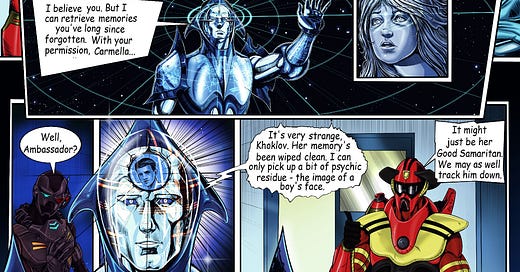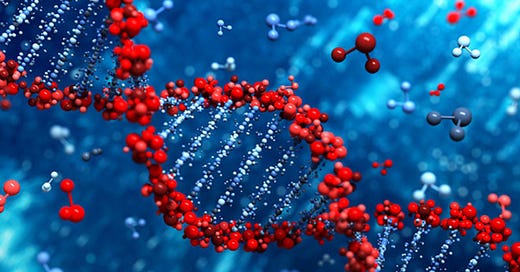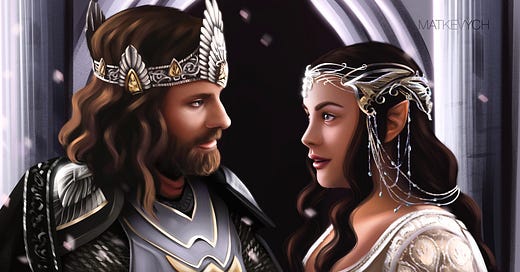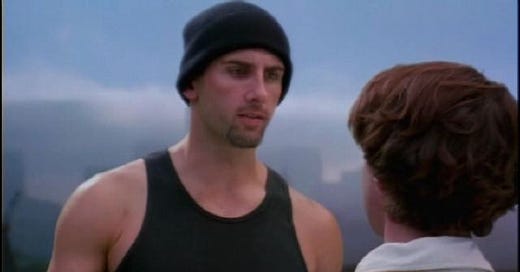AI Illustration Contest: Who Won First Prize and How
Congratulations Erickson L./@DorianLudevig!
Last July, I announced $2000 in prizes for my AI Illustration Contest. The 1st-prize winner was a Venezuelan artist who works under the handle @DorianLudevig, aka Erickson L. Here are write-ups for the four runner-ups.
Announcement: The second stage of the contest starts on October 1. The contest is open to the five finalists, plus up to TWO other artists selected by me. If you think you should be one of the two, please email me (a) your portfolio, and (b) a brief discussion of how you plan to combine human skill and AI to win.
In stage 2, there are no runner-ups, just a $2000 prize for the winner.
What are you up against? Here is the winning entry for stage one:
What was the mix of AI and human skill involved? Here’s Dorian/Erickson in his own words:
Technically it has not been necessary for me to go to the A.I. image generation tools to develop this page that I present in your contest.
I'm pretty good at mastering traditional techniques, and those skills are still much more useful and practical to me today than what I can achieve with A.I.
I tried designing some ideas using LEONARDO.AI , which is the image generator I've become most familiar with, but didn't get satisfactory results.
The disproportions, and the lack of precision to obtain the result that is requested from the image generator is quite frustrating.
Likewise, I have tried other image generators, and the same limitations are present to a greater or lesser extent in all of them.
I think that for a person without very strong skills in the domain of drawing and artistic composition, artificial intelligence image generators can be very useful, because despite the fact that they present many flaws, they are still more efficient than what said user could achieve with his limited artistic skills.
But in my personal case, the designs that I could get with the AI image generator lacked consistency, were unoriginal, very direct copies of traditional designs of other comic characters... and many people may not realize plagiarism so direct, but an artist with some experience and quite familiar with artistic styles can easily notice the lack of originality and creativity in the results obtained with the A.I. image generator.
I resorted to my traditional way of working, looking for sources of inspiration from other works, I analyzed some elements of the artist Jean Giraud Moebius, some Marvel comics, and took into account P. Craig Russell's Ring of the Nibelung adaptation as a reference.
And here is a comparison that has been presented in the debates on the mimicry of artificial intelligence, which justifies that it cannot be considered plagiarism since artists also feed from external sources...
It is true that most amateur artists apply direct mimicry due to a lack of experience, but an artist with a reasonable level of experience has learned to discover their own methods to digest the reference sources from which they draw inspiration to transform it into a process. Of much more elastic reinterpretations and not in an obvious process of copying ideas.
To give an example, it will be difficult to explain why this is something difficult to understand with words, it is something very visual: When I see a graphic element that seems very interesting to me in one work, I can use that same graphic element to apply it in another concept very different from that of the work from which I was inspired... or inversely many times it is not the graphic element that is special, but rather the concept that is hidden in said element, and it is precisely that concept that I end up using to apply it in another graphic situation very different from that of the work that served as a source of inspiration... situations that arise in the artist's creative process are too subjective.
With the modest experience that I have using A.I., I have not managed to achieve that versatile creation form, it is like working with a severed or chained hand, when using A.I.
But although I don't have a lot of experience using A.I., I have been very aware of what other artists who are much more immersed in artificial intelligence do, and without a doubt many others do achieve much more interesting things... but also mimicry in those works is still very rigid, in almost everything I've seen generated with A.I.
For greater efficiency THE IMAGE GENERATOR requires training, and that is something I did not resort to... for practical reasons, training the IMAGE GENERATOR requires time and work.
For this first stage, the time lapses were not viable to experiment with this whole process... without a doubt it was much more practical for me to resort to my traditional skills, which I dominate quite well.
Although in any case if you consider that it is essential, I am open to the opening, to apply the AI at a certain more advanced stage of the project.
Since I believe that at an already advanced stage of the project, artificial intelligence may be more useful, since it needs a good base of original material previously designed in a traditional way to be oriented and fed... and not the other way around.
The A.I. are a new tool with a lot of potential, but the Tools are not the essence of artistic work, they are just a resource to lean on.
And here is one of the big problems, why the results generated by this technology do not go beyond just being some peculiar attempts at artistic imitation... the real artists have not had much interest, and it is the artists who can use that tool to make true works of art...
And on the contrary, many people outside the field of art or with limited experience and knowledge in said field, are the ones who have seen the opportunity to become an artist with the use of this tool, but it is a false illusion. These same users are not interested before acquiring the minimum that is needed in previous artistic skills and knowledge... because you have to understand and use A.I. for what it is, one more tool to enhance art, instead of seeing it as a magical entity that came to replace and make obsolete the most conventional art.
I saw clear examples in this contest, most of the participants who used A.I. limited themselves to leaving all the work in the hands of that technological resource.
One participant made a lot of emphasis that he needed more time for the training of the A.I., but once the A.I. reached such training, he would have the ability to generate each art consistently in an industrial way… I wonder what material he was planning would fuel that workout?
I think that his plan could give very interesting results if the material he had in mind to fuel the training of the AI was a good cocktail of carefully worked design... cocktail prepared by a true artist.
On the contrary, if that cocktail from 0 were a recycling of images downloaded from the Internet cloud, or directly taken from the same A.I. image generator, the results will always be mediocre.
Finally, my process was not special, I looked at previous references from other artists to guide me, I began to draw the first designs of the 3 characters freehand, once I had the costumes finalized, I began to sketch the pages using the CLIP STUDIO PAINT program, with my HUION HS611 TABLET… after having the sketches coherently proportioned, draw in an overlay layer all the final ink scheme… and once having all the linear structure of the unicolor inking… finish with the color layers and the last details of brightness and shadows.
Subscribe to Bet On It
Caplan and Candor

















Impressive!!! The comic draws you in. Did they track down the good samaritan ! 😊